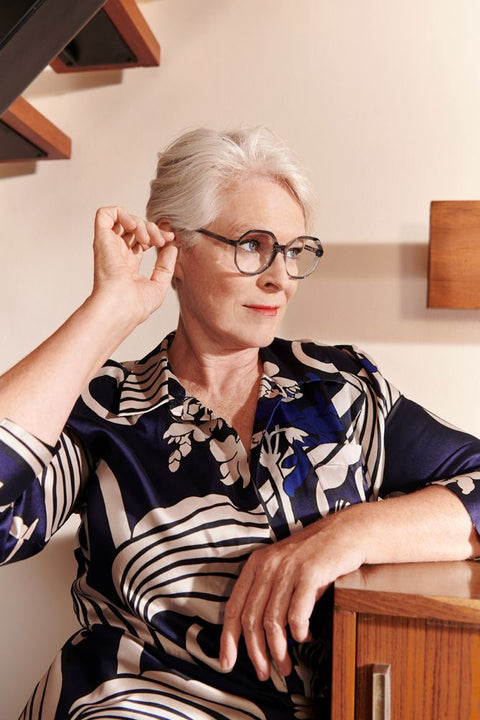Starting at age 40, women may experience various changes in their vision due to the natural aging process and specific hormonal factors. These changes can affect their quality of life and, sometimes, their ability to perform daily activities.
Taking care of your eyes after age 40 is essential to prevent common eye problems associated with aging and maintain a good quality of life. Here are some practical tips to preserve your vision health:
Get regular eye exams
We recommend that you visit your ophthalmologist at least once a year to detect problems such as presbyopia, glaucoma, or macular degeneration in their early stages.
If you're over 40 and haven't been to the ophthalmologist in a while, we recommend making a visit, even if you don't feel you need to; it will help you establish a baseline for future checkups.
Protect your eyes from sunlight
Wear sunglasses with UV protection (UVA and UVB) to prevent retinal damage and premature cataract development.
Wear hats, caps, or visors on sunny days to reduce direct sun exposure.
Follow a healthy diet (for your vision)
Consuming foods rich in vitamins A, C, E, and zinc, such as carrots, spinach, citrus fruits, and walnuts, and omega-3 fatty acids, such as fatty fish (salmon, sardines) or chia seeds, will help improve the health of your retina.
Antioxidants in green leafy vegetables and corn (lutein and zeaxanthin) will help protect you against macular degeneration.
Hydrate your eyes
Stay well hydrated to avoid dry eye syndrome by using artificial tears (you can find them at your pharmacy or drugstore) if you spend many hours in front of screens or in dry environments.
Limit screen time
We're BIG fans of the 20-20-20 rule : Every 20 minutes, look at something 20 feet (6 meters) away for at least 20 seconds to reduce eye strain.
Adjust the brightness and contrast of your screens to make them comfortable for your eyes, and use blue light filters or special glasses if you spend long hours in front of electronic devices.
Don't ignore your symptoms
Consult a specialist if you notice blurred vision, floating spots, flashes of light, difficulty seeing up close, or any sudden change in your vision… it may only be something you can fix with reading glasses… or it could be something more serious.
Manage your chronic diseases
If you have diabetes and high blood pressure, you should strictly follow your medication and doctor's instructions. Keeping these instructions under control is essential to reduce the risk of developing diabetic retinopathy or ocular vascular damage. And don't hesitate to consult your doctor if you notice any problems with your vision.
Quit smoking
Smoking increases your risk of macular degeneration, cataracts, and other serious eye diseases. Quitting this habit improves your eye health and, of course, your overall health.
Wear eye protection during specific activities
Wear protective eyewear if you work with tools, chemicals, or during contact sports to avoid injuries. If you enjoy gardening, we recommend some type of eyewear to protect you from branches that could scratch your eyes.
Get adequate rest.
Getting enough sleep helps your eyes recover from daily stress and reduces dry eyes, as well as dark circles!
Avoid expired makeup
Use quality products and replace them regularly to avoid eye infections. Expired makeup can be full of bacteria that can harm your eyes and skin...and never share eye makeup.
Consultation on the use of appropriate glasses or contact lenses
If you have presbyopia or other vision problems, use reading glasses, progressive lenses, or glasses with filters to reduce eye fatigue…there are many models to choose from, and your eyes will thank you!
Adopting these habits can help you maintain healthy vision for longer and prevent serious complications, because a preventive and proactive attitude is key after age 40.
Unfortunately, from the age of 40 onwards, many women suffer from vision problems…some such as:
Presbyopia
It is characterized by difficulty focusing on close objects, which can make activities such as reading or using mobile devices difficult. This phenomenon occurs due to the gradual loss of flexibility of the crystalline lens, the eye's natural lens that allows for focusing. With age, the lens becomes less elastic, reducing its ability to accommodate.
Dry Eye Syndrome
This syndrome is more prevalent in women over 40 and is due to a decrease in tear production or excessive tear evaporation, causing symptoms such as burning, itching, and a foreign body sensation in the eye. Hormonal changes associated with menopause can influence the quality and quantity of tears.
Waterfalls
Cataracts involve clouding of the lens, leading to blurred or cloudy vision.
Factors such as prolonged exposure to ultraviolet light, smoking, and systemic diseases like diabetes can accelerate its onset. Early detection and appropriate treatment are essential to prevent significant vision loss.
Age-related Macular Degeneration (AMD)
This disease can lead to a progressive loss of central vision, making tasks such as reading or recognizing faces difficult. Although AMD is more common in people over 60, women over 40 should be aware of risk factors, which include family history, smoking, and a diet low in antioxidants. Early detection and appropriate interventions can slow its progression.
Glaucoma
Glaucoma is a group of diseases that damage the optic nerve, usually due to elevated intraocular pressure. It is one of the leading causes of irreversible blindness. It is important to undergo regular eye exams to detect early signs of glaucoma, as it is often asymptomatic in its early stages. Early diagnosis and treatment are essential to preserve vision.
Diabetic Retinopathy
Women with diabetes have an increased risk of developing diabetic retinopathy, a complication that damages the blood vessels in the retina. Strict control of blood glucose levels and regular eye evaluations are crucial to prevent or minimize eye damage associated with this condition.
Retinal Detachment
As we age, the vitreous (the jelly-like fluid in the center of the eye) undergoes texture changes and can shrink, increasing the risk of retinal detachment. Women over 40 should be alert for symptoms such as the sudden appearance of floaters or flashes of light and seek immediate medical attention if these occur.
The importance of periodic check-ups
Because many eye diseases can progress without obvious symptoms in their early stages, it is essential for women over the age of 40 to have regular comprehensive eye exams.
Literature
· People over 40. (2022, April 12). IMO; IMO Miranza Group. https://www.imo.es/guias-y-consejos/grupos-de-riesgo/mayores-de-40-anos/
· Jürgens, I. (2016, December 20). Eye health in adults aged 40 to 60. ICR; Catalan Retina Institute. https://icrcat.com/salud-ocular/adultos-40-60/
· The importance of eye exams over the years. (n.d.). Barraquer Ophthalmology Center. Retrieved January 19, 2025, from https://www.barraquer.com/noticias/relevancia-revisiones-oculares
· Porter, D., & Boyd, K. (2019, December 28). Get Screened for Eye Diseases at Age 40. American Academy of Ophthalmology.
Madequa - Madecua




Comments (0)
There are no comments for this article. Be the first one to leave a message!